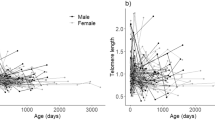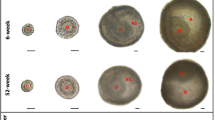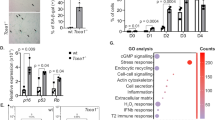Abstract
Telomere length is a crucial factor in senescence1,2,3, but it has not been determined whether animals with long telomeres live longer than those with normal-length telomeres in the isogenic background of a given species. Here we show the effect of long telomeres on lifespan in the nematode Caenorhabditis elegans. We examined the effect of telomere length on lifespan by overexpressing HRP-1, a telomere-binding protein, which gradually increased telomere length in worms. Worms with longer telomeres lived longer. We confirmed that the extension of lifespan was due to the increased telomere length, and not to the overexpression of HRP-1 per se, by examining the lifespans of nontransgenic progeny of the transgenic worms, who retained the longer telomeres. The lifespan-extending effect of long telomeres was dependent on daf-16. The number of germ stem cells was not affected in worms with long telomeres, indicating that the telomere effect on lifespan is independent of germ stem cell cycling. Worms with long telomeres were more resistant to heat stress. Taken together, our results suggest that signaling may be initiated in postmitotic somatic cells by telomere length to regulate organismal lifespan.
This is a preview of subscription content, access via your institution
Access options
Subscribe to this journal
Receive 12 print issues and online access
$259.00 per year
only $21.58 per issue
Buy this article
- Purchase on SpringerLink
- Instant access to full article PDF
Prices may be subject to local taxes which are calculated during checkout




Similar content being viewed by others
References
Krupp, G., Klapper, W. & Parwaresch, R. Cell proliferation, carcinogenesis and diverse mechanisms of telomerase regulation. Cell Mol. Life Sci. 57, 464–486 (2000).
Morin, G.B. Telomere control of replicative lifespan. Exp. Gerontol. 32, 375–382 (1997).
Harley, C.B., Vaziri, H., Counter, C.M. & Allsopp, R.C. The telomere hypothesis of cellular aging. Exp. Gerontol. 27, 375–382 (1992).
Rudolph, K.L. et al. Longevity, stress response, and cancer in aging telomerase-deficient mice. Cell 96, 701–712 (1999).
Bodnar, A.G. et al. Extension of life-span by introduction of telomerase into normal human cells. Science 279, 349–352 (1998).
Hemann, M.T. & Greider, C.W. Wild-derived inbred mouse strains have short telomeres. Nucleic Acids Res. 28, 4474–447 (2000).
Wicky, C. et al. Telomeric repeats (TTAGGC)n are sufficient for chromosome capping function in Caenorhabditis elegans. Proc. Natl. Acad. Sci. USA 93, 8983–8988 (1996).
Lin, J.J. & Zakian, V.A. Isolation and characterization of two Saccharomyces cerevisiae genes that encode proteins that bind to (TG1-3)n single strand telomeric DNA in vitro. Nucleic Acids Res. 22, 4906–4913 (1994).
LaBranche, H. et al. Telomere elongation by hnRNP A1 and a derivative that interacts with telomeric repeats and telomerase. Nat. Genet. 19, 199–202 (1998).
Fiset, S. & Chabot, B. hnRNP A1 may interact simultaneously with telomeric DNA and the human telomerase RNA in vitro. Nucleic Acids Res. 29, 2268–2275 (2001).
Ketting, R.F., Haverkamp, T.H., van Luenen, H.G. & Plasterk, R.H. Mut-7 of C. elegans, required for transposon silencing and RNA interference, is a homolog of Werner syndrome helicase and RNaseD. Cell 99, 133–141 (1999).
Lithgow, G.J., White, T.M., Hinerfeld, D.A. & Johnson, T.E. Thermotolerance of a long-lived mutant of Caenorhabditis elegans. J. Gerontol. 49, B270–276 (1994).
Lithgow, G.J., White, T.M., Melov, S. & Johnson, T.E. Thermotolerance and extended life-span conferred by single-gene mutations and induced by thermal stress. Proc. Natl. Acad. Sci. USA 92, 7540–7544 (1995).
Honda, Y. & Honda, S. The daf-2 gene network for longevity regulates oxidative stress resistance and Mn-superoxide dismutase gene expression in Caenorhabditis elegans. FASEB J. 13, 1385–1393 (1999).
Larsen, P.L. Aging and resistance to oxidative damage in Caenorhabditis elegans. Proc. Natl. Acad. Sci. USA 90, 8905–8909 (1993).
Lin, K., Dorman, J.B., Rodan, A. & Kenyon, C. daf-16: An HNF-3/forkhead family member that can function to double the life-span of Caenorhabditis elegans. Science 278, 1319–1322 (1997).
Ogg, S. et al. The Fork head transcription factor DAF-16 transduces insulin-like metabolic and longevity signals in C. elegans. Nature 389, 994–999 (1997).
Lin, K., Hsin, H., Libina, N. & Kenyon, C. Regulation of the Caenorhabditis elegans longevity protein DAF-16 by insulin/IGF-1 and germline signaling. Nat. Genet. 28, 139–145 (2001).
Hsin, H. & Kenyon, C. Signals from the reproductive system regulate the lifespan of C. elegans. Nature 399, 362–366 (1999).
Benard, C. et al. The C. elegans maternal-effect gene clk-2 is essential for embryonic development, encodes a protein homologous to yeast Tel2p and affects telomere length. Development 128, 4045–4055 (2001).
Lim, C.S., Mian, I.S., Dernburg, A.F. & Campisi, J. C. elegans clk-2, a gene that limits life span, encodes a telomere length regulator similar to yeast telomere binding protein Tel2p. Curr. Biol. 11, 1706–1710 (2001).
Ahmed, S., Alpi, A., Hengartner, M.O. & Gartner, A. C. elegans RAD-5/CLK-2 defines a new DNA damage checkpoint protein. Curr. Biol. 11, 1934–194. (2001).
Benard, C. & Hekimi, S. Long-lived mutants, the rate of aging, telomeres and the germline in Caenorhabditis elegans. Mech. Ageing Dev. 123, 869–880 (2002).
Cawthon, R.M., Smith, K.R., O'Brien, E., Sivatchenko, A. & Kerber, R.A. Association between telomere length in blood and mortality in people aged 60 years or older. Lancet 361, 393–395 (2003).
Kwon, J.Y. et al. Caenorhabditis elegans mediator complexes are required for developmental-specific transcriptional activation. Proc. Natl. Acad. Sci. USA 96, 14990–14995 (1999).
Mello, C.C., Kramer, J.M., Stinchcomb, D. & Ambros, V. Efficient gene transfer in C. elegans: extrachromosomal maintenance and integration of transforming sequences. EMBO J. 10, 3959–3970 (1991).
Garigan, D. et al. Genetic analysis of tissue aging in Caenorhabditis elegans: a role for heat-shock factor and bacterial proliferation. Genetics 161, 1101–1112 (2002).
Acknowledgements
We thank C. Kenyon for her comments and invaluable advice on this project, A. Fire for the vectors and CGC for the strains. This project was supported by the Molecular Aging Research Center Grant (HPEB, Korea).
Author information
Authors and Affiliations
Corresponding author
Ethics declarations
Competing interests
The authors declare no competing financial interests.
Rights and permissions
About this article
Cite this article
Joeng, K., Song, E., Lee, KJ. et al. Long lifespan in worms with long telomeric DNA. Nat Genet 36, 607–611 (2004). https://doi.org/10.1038/ng1356
Received:
Accepted:
Published:
Issue date:
DOI: https://doi.org/10.1038/ng1356
This article is cited by
-
Telomere Length is a Susceptibility Marker for Tasmanian Devil Facial Tumor Disease
EcoHealth (2020)
-
Splicing factors control C. elegans behavioural learning in a single neuron by producing DAF-2c receptor
Nature Communications (2016)
-
Rapid growth accelerates telomere attrition in a transgenic fish
BMC Evolutionary Biology (2015)
-
Heritability of telomere length in the Zebra Finch
Journal of Ornithology (2015)
-
Telomere dynamics in a long-lived bird, the barnacle goose
BMC Evolutionary Biology (2012)



